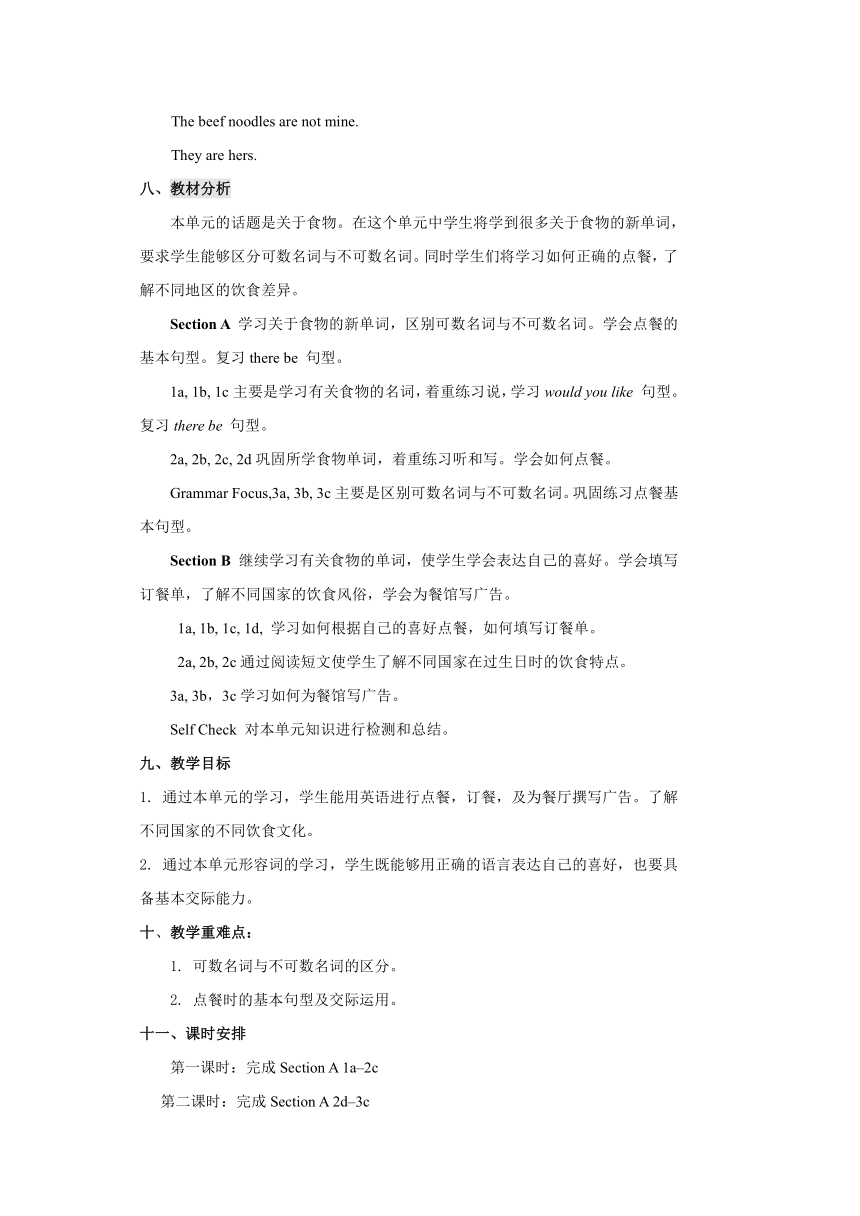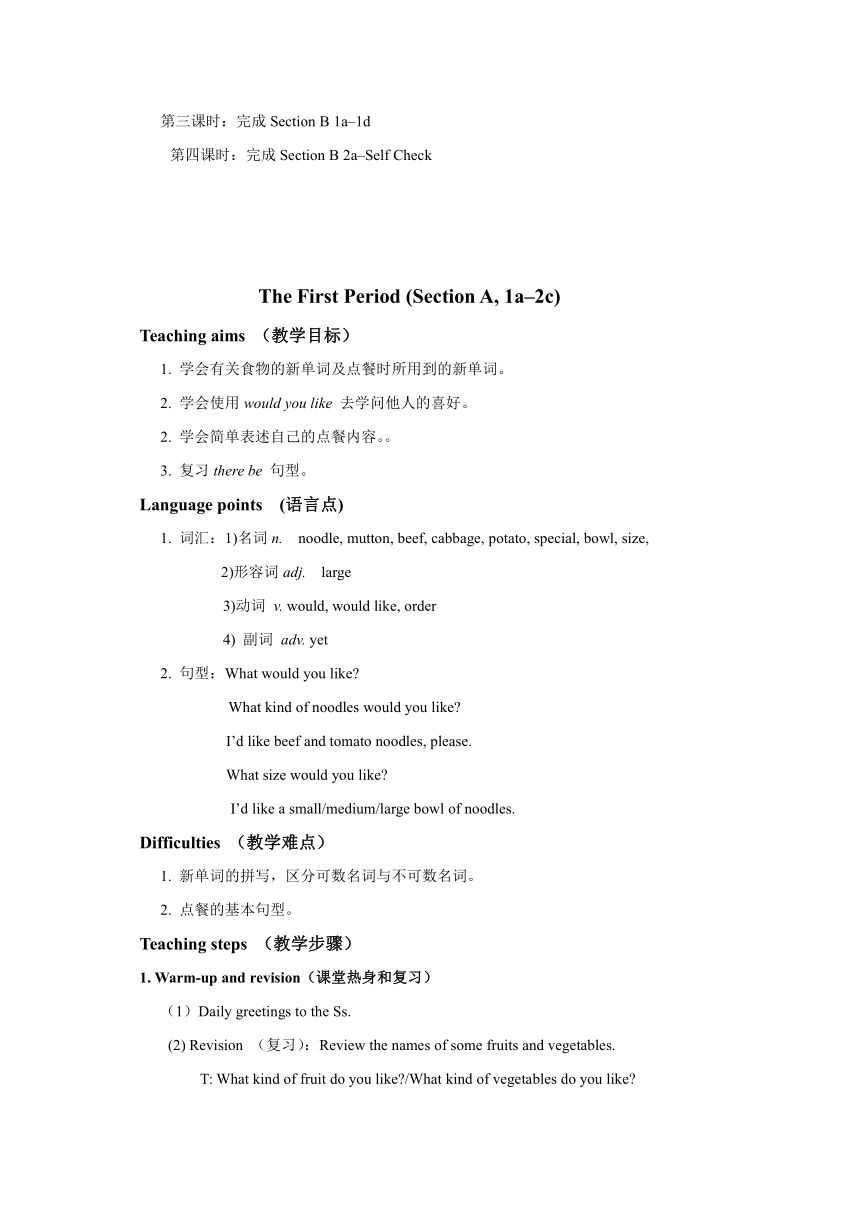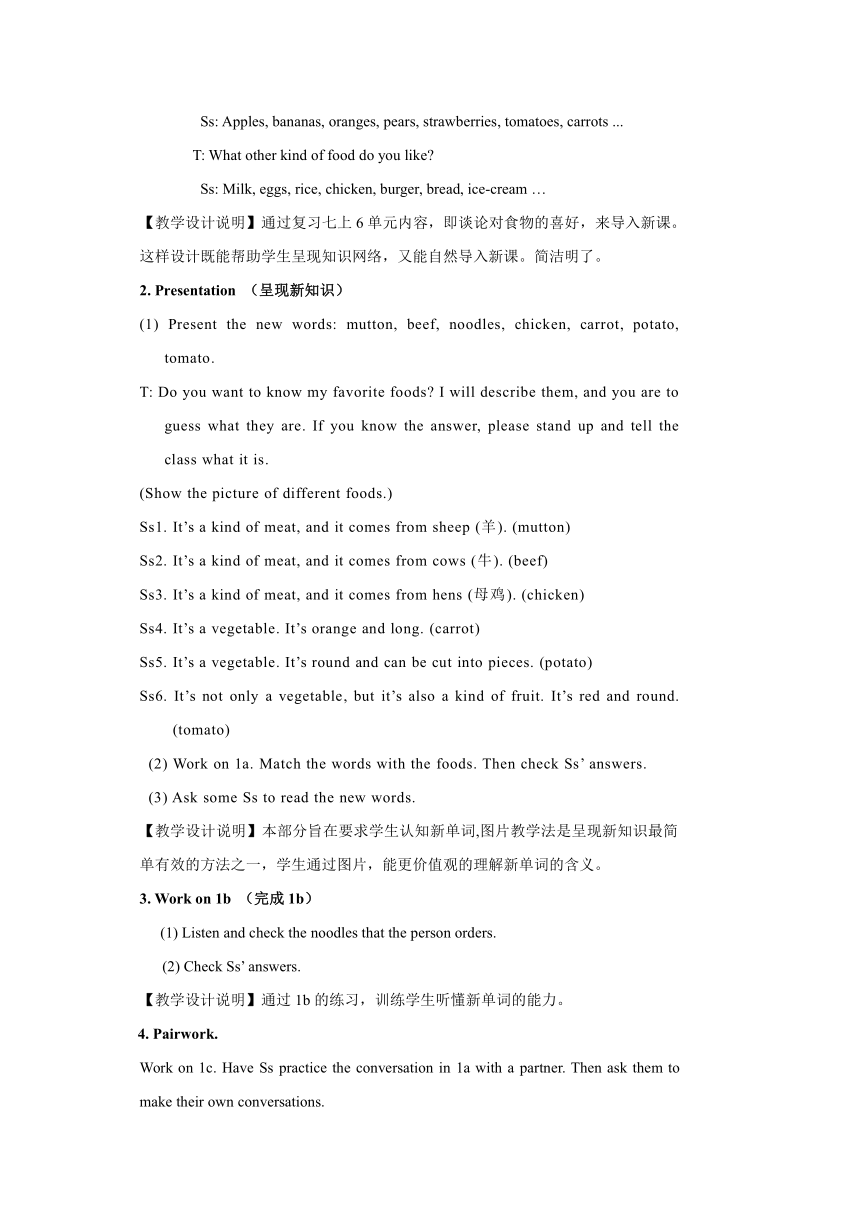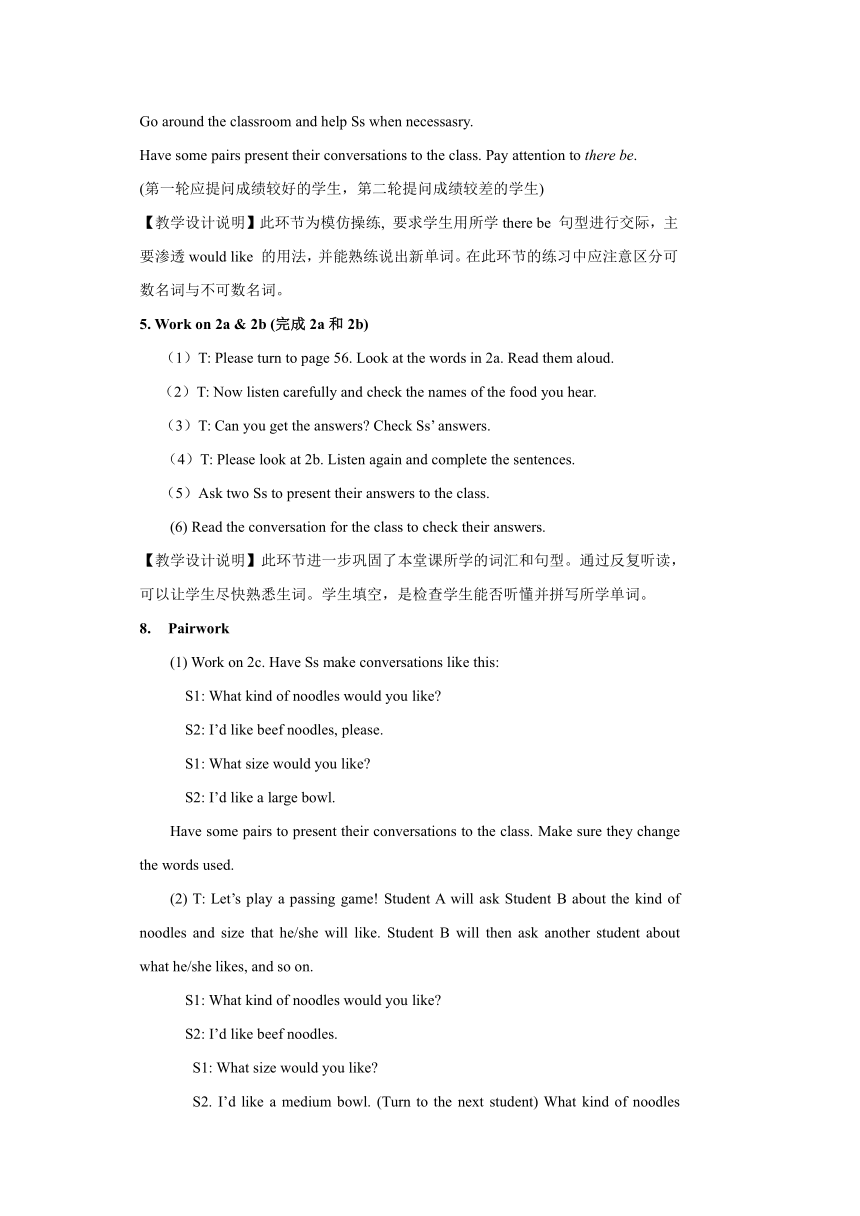Unit 10 I’d like some noodles.(4课时教案)
文档属性
| 名称 | Unit 10 I’d like some noodles.(4课时教案) |  | |
| 格式 | zip | ||
| 文件大小 | 26.7KB | ||
| 资源类型 | 教案 | ||
| 版本资源 | 人教新目标(Go for it)版 | ||
| 科目 | 英语 | ||
| 更新时间 | 2014-06-04 21:40:59 | ||
图片预览





文档简介
Unit 10 I’d like some noodles.
Learning Objectives
一、Topics(话题):
Food
二、Functions (功能)
Order food
三、Structures (结构)
1. would like
2. What questions
3. some/any
四、Target Language (目标语言)
What kind of noodles would you like?
I’d like beef and tomato noodles, please.
What size would you like?
I’d like a small/medium/large bowl of noodles.
Would you like any drinks?
One large green tea.
五、Vocabulary (词汇)
beef, noodles, cabbage, potato, meat, fish, dumpling, soup, pancake, cake, bowl, size, order, large, popular, special
would like, take one’s order, two bowls of …, blow out …, make a wish, get popular, cut up …, bring good luck to …
六、Skills (技能)
Listening for key information
Scanning in reading
七、Recycling (复习巩固)
Numbers 1-9
Is there …?
Are there …?
The beef noodles are not mine.
They are hers.
八、教材分析
本单元的话题是关于食物。在这个单元中学生将学到很多关于食物的新单词,要求学生能够区分可数名词与不可数名词。同时学生们将学习如何正确的点餐,了解不同地区的饮食差异。
Section A 学习关于食物的新单词,区别可数名词与不可数名词。学会点餐的基本句型。复习there be 句型。
1a, 1b, 1c主要是学习有关食物的名词,着重练习说,学习would you like 句型。复习there be 句型。
2a, 2b, 2c, 2d巩固所学食物单词,着重练习听和写。学会如何点餐。
Grammar Focus,3a, 3b, 3c主要是区别可数名词与不可数名词。巩固练习点餐基本句型。
Section B 继续学习有关食物的单词,使学生学会表达自己的喜好。学会填写订餐单,了解不同国家的饮食风俗,学会为餐馆写广告。
1a, 1b, 1c, 1d, 学习如何根据自己的喜好点餐,如何填写订餐单。
2a, 2b, 2c通过阅读短文使学生了解不同国家在过生日时的饮食特点。
3a, 3b,3c学习如何为餐馆写广告。
Self Check 对本单元知识进行检测和总结。
九、教学目标
1. 通过本单元的学习,学生能用英语进行点餐,订餐,及为餐厅撰写广告。了解不同国家的不同饮食文化。
2. 通过本单元形容词的学习,学生既能够用正确的语言表达自己的喜好,也要具备基本交际能力。
十、教学重难点:
1. 可数名词与不可数名词的区分。
2. 点餐时的基本句型及交际运用。
十一、课时安排
第一课时:完成Section A 1a–2c
第二课时:完成Section A 2d–3c
第三课时:完成Section B 1a–1d
第四课时:完成Section B 2a–Self Check
The First Period (Section A, 1a–2c)
Teaching aims (教学目标)
1. 学会有关食物的新单词及点餐时所用到的新单词。
2. 学会使用would you like 去学问他人的喜好。
2. 学会简单表述自己的点餐内容。。
3. 复习there be 句型。
Language points (语言点)
1. 词汇:1)名词n. noodle, mutton, beef, cabbage, potato, special, bowl, size,
2)形容词adj. large
3)动词 v. would, would like, order
4) 副词 adv. yet
2. 句型:What would you like?
What kind of noodles would you like?
I’d like beef and tomato noodles, please.
What size would you like?
I’d like a small/medium/large bowl of noodles.
Difficulties (教学难点)
1. 新单词的拼写,区分可数名词与不可数名词。
2. 点餐的基本句型。
Teaching steps (教学步骤)
1. Warm-up and revision(课堂热身和复习)
(1)Daily greetings to the Ss.
(2) Revision (复习):Review the names of some fruits and vegetables.
T: What kind of fruit do you like?/What kind of vegetables do you like?
Ss: Apples, bananas, oranges, pears, strawberries, tomatoes, carrots ...
T: What other kind of food do you like?
Ss: Milk, eggs, rice, chicken, burger, bread, ice-cream …
【教学设计说明】通过复习七上6单元内容,即谈论对食物的喜好,来导入新课。这样设计既能帮助学生呈现知识网络,又能自然导入新课。简洁明了。
2. Presentation (呈现新知识)
(1) Present the new words: mutton, beef, noodles, chicken, carrot, potato, tomato.
T: Do you want to know my favorite foods? I will describe them, and you are to guess what they are. If you know the answer, please stand up and tell the class what it is.
(Show the picture of different foods.)
Ss1. It’s a kind of meat, and it comes from sheep (羊). (mutton)
Ss2. It’s a kind of meat, and it comes from cows (牛). (beef)
Ss3. It’s a kind of meat, and it comes from hens (母鸡). (chicken)
Ss4. It’s a vegetable. It’s orange and long. (carrot)
Ss5. It’s a vegetable. It’s round and can be cut into pieces. (potato)
Ss6. It’s not only a vegetable, but it’s also a kind of fruit. It’s red and round. (tomato)
(2) Work on 1a. Match the words with the foods. Then check Ss’ answers.
(3) Ask some Ss to read the new words.
【教学设计说明】本部分旨在要求学生认知新单词,图片教学法是呈现新知识最简单有效的方法之一,学生通过图片,能更价值观的理解新单词的含义。
3. Work on 1b (完成1b)
(1) Listen and check the noodles that the person orders.
(2) Check Ss’ answers.
【教学设计说明】通过1b的练习,训练学生听懂新单词的能力。
4. Pairwork.
Work on 1c. Have Ss practice the conversation in 1a with a partner. Then ask them to make their own conversations.
Go around the classroom and help Ss when necessasry.
Have some pairs present their conversations to the class. Pay attention to there be.
(第一轮应提问成绩较好的学生,第二轮提问成绩较差的学生)
【教学设计说明】此环节为模仿操练, 要求学生用所学there be 句型进行交际,主要渗透would like 的用法,并能熟练说出新单词。在此环节的练习中应注意区分可数名词与不可数名词。
5. Work on 2a & 2b (完成2a和2b)
(1)T: Please turn to page 56. Look at the words in 2a. Read them aloud.
(2)T: Now listen carefully and check the names of the food you hear.
(3)T: Can you get the answers? Check Ss’ answers.
(4)T: Please look at 2b. Listen again and complete the sentences.
(5)Ask two Ss to present their answers to the class.
(6) Read the conversation for the class to check their answers.
【教学设计说明】此环节进一步巩固了本堂课所学的词汇和句型。通过反复听读,可以让学生尽快熟悉生词。学生填空,是检查学生能否听懂并拼写所学单词。
8. Pairwork
(1) Work on 2c. Have Ss make conversations like this:
S1: What kind of noodles would you like?
S2: I’d like beef noodles, please.
S1: What size would you like?
S2: I’d like a large bowl.
Have some pairs to present their conversations to the class. Make sure they change the words used.
(2) T: Let’s play a passing game! Student A will ask Student B about the kind of noodles and size that he/she will like. Student B will then ask another student about what he/she likes, and so on.
S1: What kind of noodles would you like?
S2: I’d like beef noodles.
S1: What size would you like?
S2. I’d like a medium bowl. (Turn to the next student) What kind of noodles would you like?
S3: I’d like tomato noodles.
S2: What size would you like?
S3: I’d like a small bowl of noodles. (Turn to the next student) What kind of noodles would you like?
【教学设计说明】此环节既能充分练习学生的目标语言,使学生学以致用,同时也能尽可能给更多的学生开口说的机会。此环节应让全班至少50%的同学参与进来。
10. Homework (课后作业)
Oral: 朗读并熟记第55页的单词和句子。
Written: 1.抄写第55页的单词和句子。
2. 将所有学过的表示食物的名词按照可数名词,不可数名词,既是可数名词又是不可数名词分为三类,写在笔记本上。
The Second Period (Section A, 2d–3d)
Teaching aims (教学目标)
1. 能在日常情境中熟练在餐馆里点餐。
2. 能用所学内容解决实际问题。
3. 区别可数名词与不可数名词。
Language points (语言点)
1. 词汇:1) 名词n. tofu, meat
2. 句型:What would you like?
What kind of noodles would you like?
I’d like beef and tomato noodles, please.
What size would you like?
I’d like a small/medium/large bowl.
Difficulties (教学难点)
1. 清楚地区别可数名词与不可数名词。
2. 熟练掌握点餐句型。
Teaching steps (教学步骤)
Warm-up and revision (课堂热身和复习)
(1) Show Ss some pictures of food.
(2)Show pictures of different kinds of noodles and have Ss name them. Show Ss the difference between a small/medium/large bowl too.
【教学设计说明】通过谈论图片,既能复习之前单元所学内容,又可以自然过渡到下一个环节,并能帮助学生理解阅读内容。
2. Work on 2d (完成2d)
(1)The girl in the picture is Sally, and the boy is her friend, Tom. They are in a restaurant ordering food. Explain to Ss what “order” means. Role-play the conversation in 2d.
(2) Follow the example in 2d and make up a conversation to order some food.
(3) Read the conversation and answer the following questions.
Q1. Are there any tomatoes in the beef soup?
Yes, there are.
Q2. How many bowls of beef soup do they need?
One.
Q3. What else does Tom like?
He likes gongbao chicken and some mapo tofu with rice.
【教学设计说明】学生通过回答问题能理解对话的内容,通过角色扮演能在情境中学会运用,通过自编对话能更好的让学生学以致用。
3. Grammar Focus
(1) Read through the sentences.
(2) Ask Ss to focus on the countable and uncountable nouns.
【教学设计说明】本部分为本单元的内容核心,不仅概括了本单元的重点,还将基本句型一 一呈现。由于是总结性内容,故要求学生朗读。可在课后将本部分列入听写内容。此处可配合学生上一课时的课后作业,纠正学生错误,帮助学生归纳总结。
4. Work on 3a (完成3a)
(1) Complete the conversation in 3a.
(2) Check Ss’ answers.
(3) Have Ss get into pairs and role-play the conversation to familiarize themselves with the ordering process. Ask them to change the words used.
【教学设计说明】本部分旨在强化点餐句型,使学生关注点餐细节。
5. Work on 3b (完成3b)
Write questions and answers using the words in brackets.
【教学设计说明】巩固3a内容。
6. Work on 3c (完成3d)
Have Ss get into groups and make conversations about the picture.【教学设计说明】 本环节要求学生能够活学活用,真正达到掌握目标语言的能力。
7. Homework (课后作业)
Get into groups and work on 3c. Then, make a conversation about ordering food.
The Third Period (Section B, 1a–1d)
Teaching aims (教学目标)
1. 继续学习有关食物的名词。
2. 能熟练谈论自己喜爱的食物。
3. 学会如何使用电话点餐,及如何填写订餐表格。
4. 理解听力材料。
Language points (语言点)
1. 词汇:1) 名词n. dumpling, porridge, onion, fish, pancake.
2. 句型: I like …, … and….
I don’t like … or …
Difficulties (教学难点)
1. 否定句中and 换成or。
2. 熟练掌握电话订餐。
Teaching steps (教学步骤)
1. Warm-up and revision(课堂热身和复习)
(1) Check Ss’ homework. Ask some groups to present their conversations to the class.
(2) Ask some Ss why they would like … (引导学生说出like)
【教学设计说明】1.复习了点餐句型和所学单词。2. 通过询问学生为什么要点某道菜,引导学生说出本课时的句型:I like … and …
Presentation (呈现新知识)
(1) T: There is going to be a party. And we have to prepare some food and drinks for it. What should we prepare? Here are some pictures. Please tell me what they are.
(Show pictures of the new words.)
1. It’s a traditional Chinese food, and we usually eat it during the Spring Festival. (dumpling)
2. Cats like to eat this. It lives under water. (fish)
3. It’s a kind of drink and it’s made of orange.
4. It’s a kind of tea and it’s popular in China.
Here are some other foods. What are they? (直接出示图片) Have Ss name the food items that they see in the picture.
(2) Work on 1a. Match the words with the pictures.
【教学设计说明】通过对每幅图片的描述,引导学生由使用旧知识过渡到自主使用新知识,达到了自然呈现的目的。
Pairwork
Work on 1b. Circle the things you like in 1a. Put an X next to the things you don’t like.
Tell your partner what you like and don’t like.
A: What do you like in the picture?
B: I like dumplings, fish and orange juice.
A: What don’t you like?
B: I don’t like onions, green tea or porridge.
注:and 用于肯定句中,表并列关系,否定句中and 要换成or。
【教学设计说明】 通过对话练习使学生进一步掌握食物单词,以及and和or的基本用法,学会阐述自己喜欢的和不喜欢的。
4. Work on 1c and 1d
(1)Listen and complete the food order form.
(2)Listen again. Check your answers in 1c.
【教学设计说明】由于本环节学生需要填写的内容较多,因此建议学生连听两遍,完成表格。听第三遍时在和学生一起核对答案,
5. Pairwork
(1) Have Ss get into pairs and role-play the conversation in 1c.
(2) Have some pairs perform the conversation to the class.
【教学设计说明】 听力材料是最好的交际对话,因此可作为学生模仿的例文。此环节帮助学生更好的理解听力内容,记住关键句型。
6. Homework
1. 背诵1a单词,家长听写。
2. 背诵听力材料,并仿照听力材料自己编写
一段对话。
The Fourth Period (Section B, 2a–Self Check)
Teaching aims (教学目标)
1. 能够理解阅读文章。
2. 能够通过阅读短文使学生了解不同国家的人过生日时不同的饮食文化。
3. 能够学会如何为餐馆撰写广告。
4. 复习there be句型。
Language points (语言点)
1. 词汇:1) 名词n. world, cake, candle, age, UK, candy, idea, answer
2) 形容词adj. different, lucky, popular
3) 动词 v. answer, blow, will
4)连词 conj. if
5)短语 blow out, cut up
2. 句型:Would you like …?
We have … for …
You can try our …
… is very good/delicious.
Difficulties (教学难点)
1. 理解较长文章的大意,学会回答问题。
2. 用所学知识写出完整的文章。
Teaching steps (教学步骤)
1. Warm-up and revision(课堂热身和复习)
Have Ss discuss the question in 2a as a class.
. T: What do you do or eat on your birthday?
S1: Have a birthday party.
S2: Get some gifts from family and friends.
S3: Eat birthday cake.
S4: Eat noodles.
T: Do you know why we will do all of these things on birthdays? Let’s read the article in 2b together.
【教学设计说明】通过和学生讨论生日时吃什么、做什么自然过渡到阅读文章,并设下悬念,即为什么生日时要做哪些事情。导入自然流畅,所设悬念能充分调动孩子的好奇心。
2. Presentation (呈现新知识)
Work on 2b.
(1) Read the article about food traditions and complete the chart.
Country
Food
Special meaning
UK
A candy in the birthday cake
Lucky
China
Long noodles
Long life
【教学设计说明】本环节要求学生具有快速阅读能力,即跳读,寻找有关问题的阅读部分。
(2)Work on 2c. Read the article again and answer the questions.
Q1. How can a person make his or her birthday wish come true?
If he/she blows out all the candles in one go, his/her wish will come true.
Q2. What do people in the UK sometimes put in a birthday cake?
A candy.
Q3. Why do people never cut up birthday noodles in China?
Because long noodles are a symbol of long life.
Q4. Why do people eat special foods on their birthday?
Because they bring good luck to the birthday person.
【教学设计说明】本环节的4个问题能够帮助学生对文章有整体理解。只有读懂文章才能正确回答问题。应在本环节着重强调回答问答题的答题技巧。
3. Work on 3a
Here is an ad of an ice-cream and pancake house. Please fill in the blanks in the ad with the words in the box. Make sure Ss understand how to write an ad for a restaurant.
【教学设计说明】本部分旨在帮助学生学会用正确的语言进行写作,并帮助学生积累语言。为完成本单元的写作部分进行铺垫。
4. Work on 3b & 3c
(1) Imagine you have a restaurant. Write the foods and their prices.
Help Ss to make a menu. Show the example menu below to Ss.
Mini Noodles and Rice House
Noodles
Price
Others
Beef noodles
¥15
Rice
¥2
Mutton noodles
¥15
Juice
¥2
Chicken noodles
¥18
Milk
¥4
Tomato noodles
¥10
Soup
¥6
【教学设计说明】此环节要求学生充分发挥想象力,将自己假设为饭店老板,为自己的饭店制定菜单,既能调动学生的积极性,也为写作提供了素材。
(2)Write an ad for your restaurant. These sentences structures may help you.
Would you like …
We have … for …
You can try on our …
… is very good/delicious.
Have some Ss present their ads to the class.
4. Homework
(1) Complete Self Check.
(2)Make a poster for your ad.
Learning Objectives
一、Topics(话题):
Food
二、Functions (功能)
Order food
三、Structures (结构)
1. would like
2. What questions
3. some/any
四、Target Language (目标语言)
What kind of noodles would you like?
I’d like beef and tomato noodles, please.
What size would you like?
I’d like a small/medium/large bowl of noodles.
Would you like any drinks?
One large green tea.
五、Vocabulary (词汇)
beef, noodles, cabbage, potato, meat, fish, dumpling, soup, pancake, cake, bowl, size, order, large, popular, special
would like, take one’s order, two bowls of …, blow out …, make a wish, get popular, cut up …, bring good luck to …
六、Skills (技能)
Listening for key information
Scanning in reading
七、Recycling (复习巩固)
Numbers 1-9
Is there …?
Are there …?
The beef noodles are not mine.
They are hers.
八、教材分析
本单元的话题是关于食物。在这个单元中学生将学到很多关于食物的新单词,要求学生能够区分可数名词与不可数名词。同时学生们将学习如何正确的点餐,了解不同地区的饮食差异。
Section A 学习关于食物的新单词,区别可数名词与不可数名词。学会点餐的基本句型。复习there be 句型。
1a, 1b, 1c主要是学习有关食物的名词,着重练习说,学习would you like 句型。复习there be 句型。
2a, 2b, 2c, 2d巩固所学食物单词,着重练习听和写。学会如何点餐。
Grammar Focus,3a, 3b, 3c主要是区别可数名词与不可数名词。巩固练习点餐基本句型。
Section B 继续学习有关食物的单词,使学生学会表达自己的喜好。学会填写订餐单,了解不同国家的饮食风俗,学会为餐馆写广告。
1a, 1b, 1c, 1d, 学习如何根据自己的喜好点餐,如何填写订餐单。
2a, 2b, 2c通过阅读短文使学生了解不同国家在过生日时的饮食特点。
3a, 3b,3c学习如何为餐馆写广告。
Self Check 对本单元知识进行检测和总结。
九、教学目标
1. 通过本单元的学习,学生能用英语进行点餐,订餐,及为餐厅撰写广告。了解不同国家的不同饮食文化。
2. 通过本单元形容词的学习,学生既能够用正确的语言表达自己的喜好,也要具备基本交际能力。
十、教学重难点:
1. 可数名词与不可数名词的区分。
2. 点餐时的基本句型及交际运用。
十一、课时安排
第一课时:完成Section A 1a–2c
第二课时:完成Section A 2d–3c
第三课时:完成Section B 1a–1d
第四课时:完成Section B 2a–Self Check
The First Period (Section A, 1a–2c)
Teaching aims (教学目标)
1. 学会有关食物的新单词及点餐时所用到的新单词。
2. 学会使用would you like 去学问他人的喜好。
2. 学会简单表述自己的点餐内容。。
3. 复习there be 句型。
Language points (语言点)
1. 词汇:1)名词n. noodle, mutton, beef, cabbage, potato, special, bowl, size,
2)形容词adj. large
3)动词 v. would, would like, order
4) 副词 adv. yet
2. 句型:What would you like?
What kind of noodles would you like?
I’d like beef and tomato noodles, please.
What size would you like?
I’d like a small/medium/large bowl of noodles.
Difficulties (教学难点)
1. 新单词的拼写,区分可数名词与不可数名词。
2. 点餐的基本句型。
Teaching steps (教学步骤)
1. Warm-up and revision(课堂热身和复习)
(1)Daily greetings to the Ss.
(2) Revision (复习):Review the names of some fruits and vegetables.
T: What kind of fruit do you like?/What kind of vegetables do you like?
Ss: Apples, bananas, oranges, pears, strawberries, tomatoes, carrots ...
T: What other kind of food do you like?
Ss: Milk, eggs, rice, chicken, burger, bread, ice-cream …
【教学设计说明】通过复习七上6单元内容,即谈论对食物的喜好,来导入新课。这样设计既能帮助学生呈现知识网络,又能自然导入新课。简洁明了。
2. Presentation (呈现新知识)
(1) Present the new words: mutton, beef, noodles, chicken, carrot, potato, tomato.
T: Do you want to know my favorite foods? I will describe them, and you are to guess what they are. If you know the answer, please stand up and tell the class what it is.
(Show the picture of different foods.)
Ss1. It’s a kind of meat, and it comes from sheep (羊). (mutton)
Ss2. It’s a kind of meat, and it comes from cows (牛). (beef)
Ss3. It’s a kind of meat, and it comes from hens (母鸡). (chicken)
Ss4. It’s a vegetable. It’s orange and long. (carrot)
Ss5. It’s a vegetable. It’s round and can be cut into pieces. (potato)
Ss6. It’s not only a vegetable, but it’s also a kind of fruit. It’s red and round. (tomato)
(2) Work on 1a. Match the words with the foods. Then check Ss’ answers.
(3) Ask some Ss to read the new words.
【教学设计说明】本部分旨在要求学生认知新单词,图片教学法是呈现新知识最简单有效的方法之一,学生通过图片,能更价值观的理解新单词的含义。
3. Work on 1b (完成1b)
(1) Listen and check the noodles that the person orders.
(2) Check Ss’ answers.
【教学设计说明】通过1b的练习,训练学生听懂新单词的能力。
4. Pairwork.
Work on 1c. Have Ss practice the conversation in 1a with a partner. Then ask them to make their own conversations.
Go around the classroom and help Ss when necessasry.
Have some pairs present their conversations to the class. Pay attention to there be.
(第一轮应提问成绩较好的学生,第二轮提问成绩较差的学生)
【教学设计说明】此环节为模仿操练, 要求学生用所学there be 句型进行交际,主要渗透would like 的用法,并能熟练说出新单词。在此环节的练习中应注意区分可数名词与不可数名词。
5. Work on 2a & 2b (完成2a和2b)
(1)T: Please turn to page 56. Look at the words in 2a. Read them aloud.
(2)T: Now listen carefully and check the names of the food you hear.
(3)T: Can you get the answers? Check Ss’ answers.
(4)T: Please look at 2b. Listen again and complete the sentences.
(5)Ask two Ss to present their answers to the class.
(6) Read the conversation for the class to check their answers.
【教学设计说明】此环节进一步巩固了本堂课所学的词汇和句型。通过反复听读,可以让学生尽快熟悉生词。学生填空,是检查学生能否听懂并拼写所学单词。
8. Pairwork
(1) Work on 2c. Have Ss make conversations like this:
S1: What kind of noodles would you like?
S2: I’d like beef noodles, please.
S1: What size would you like?
S2: I’d like a large bowl.
Have some pairs to present their conversations to the class. Make sure they change the words used.
(2) T: Let’s play a passing game! Student A will ask Student B about the kind of noodles and size that he/she will like. Student B will then ask another student about what he/she likes, and so on.
S1: What kind of noodles would you like?
S2: I’d like beef noodles.
S1: What size would you like?
S2. I’d like a medium bowl. (Turn to the next student) What kind of noodles would you like?
S3: I’d like tomato noodles.
S2: What size would you like?
S3: I’d like a small bowl of noodles. (Turn to the next student) What kind of noodles would you like?
【教学设计说明】此环节既能充分练习学生的目标语言,使学生学以致用,同时也能尽可能给更多的学生开口说的机会。此环节应让全班至少50%的同学参与进来。
10. Homework (课后作业)
Oral: 朗读并熟记第55页的单词和句子。
Written: 1.抄写第55页的单词和句子。
2. 将所有学过的表示食物的名词按照可数名词,不可数名词,既是可数名词又是不可数名词分为三类,写在笔记本上。
The Second Period (Section A, 2d–3d)
Teaching aims (教学目标)
1. 能在日常情境中熟练在餐馆里点餐。
2. 能用所学内容解决实际问题。
3. 区别可数名词与不可数名词。
Language points (语言点)
1. 词汇:1) 名词n. tofu, meat
2. 句型:What would you like?
What kind of noodles would you like?
I’d like beef and tomato noodles, please.
What size would you like?
I’d like a small/medium/large bowl.
Difficulties (教学难点)
1. 清楚地区别可数名词与不可数名词。
2. 熟练掌握点餐句型。
Teaching steps (教学步骤)
Warm-up and revision (课堂热身和复习)
(1) Show Ss some pictures of food.
(2)Show pictures of different kinds of noodles and have Ss name them. Show Ss the difference between a small/medium/large bowl too.
【教学设计说明】通过谈论图片,既能复习之前单元所学内容,又可以自然过渡到下一个环节,并能帮助学生理解阅读内容。
2. Work on 2d (完成2d)
(1)The girl in the picture is Sally, and the boy is her friend, Tom. They are in a restaurant ordering food. Explain to Ss what “order” means. Role-play the conversation in 2d.
(2) Follow the example in 2d and make up a conversation to order some food.
(3) Read the conversation and answer the following questions.
Q1. Are there any tomatoes in the beef soup?
Yes, there are.
Q2. How many bowls of beef soup do they need?
One.
Q3. What else does Tom like?
He likes gongbao chicken and some mapo tofu with rice.
【教学设计说明】学生通过回答问题能理解对话的内容,通过角色扮演能在情境中学会运用,通过自编对话能更好的让学生学以致用。
3. Grammar Focus
(1) Read through the sentences.
(2) Ask Ss to focus on the countable and uncountable nouns.
【教学设计说明】本部分为本单元的内容核心,不仅概括了本单元的重点,还将基本句型一 一呈现。由于是总结性内容,故要求学生朗读。可在课后将本部分列入听写内容。此处可配合学生上一课时的课后作业,纠正学生错误,帮助学生归纳总结。
4. Work on 3a (完成3a)
(1) Complete the conversation in 3a.
(2) Check Ss’ answers.
(3) Have Ss get into pairs and role-play the conversation to familiarize themselves with the ordering process. Ask them to change the words used.
【教学设计说明】本部分旨在强化点餐句型,使学生关注点餐细节。
5. Work on 3b (完成3b)
Write questions and answers using the words in brackets.
【教学设计说明】巩固3a内容。
6. Work on 3c (完成3d)
Have Ss get into groups and make conversations about the picture.【教学设计说明】 本环节要求学生能够活学活用,真正达到掌握目标语言的能力。
7. Homework (课后作业)
Get into groups and work on 3c. Then, make a conversation about ordering food.
The Third Period (Section B, 1a–1d)
Teaching aims (教学目标)
1. 继续学习有关食物的名词。
2. 能熟练谈论自己喜爱的食物。
3. 学会如何使用电话点餐,及如何填写订餐表格。
4. 理解听力材料。
Language points (语言点)
1. 词汇:1) 名词n. dumpling, porridge, onion, fish, pancake.
2. 句型: I like …, … and….
I don’t like … or …
Difficulties (教学难点)
1. 否定句中and 换成or。
2. 熟练掌握电话订餐。
Teaching steps (教学步骤)
1. Warm-up and revision(课堂热身和复习)
(1) Check Ss’ homework. Ask some groups to present their conversations to the class.
(2) Ask some Ss why they would like … (引导学生说出like)
【教学设计说明】1.复习了点餐句型和所学单词。2. 通过询问学生为什么要点某道菜,引导学生说出本课时的句型:I like … and …
Presentation (呈现新知识)
(1) T: There is going to be a party. And we have to prepare some food and drinks for it. What should we prepare? Here are some pictures. Please tell me what they are.
(Show pictures of the new words.)
1. It’s a traditional Chinese food, and we usually eat it during the Spring Festival. (dumpling)
2. Cats like to eat this. It lives under water. (fish)
3. It’s a kind of drink and it’s made of orange.
4. It’s a kind of tea and it’s popular in China.
Here are some other foods. What are they? (直接出示图片) Have Ss name the food items that they see in the picture.
(2) Work on 1a. Match the words with the pictures.
【教学设计说明】通过对每幅图片的描述,引导学生由使用旧知识过渡到自主使用新知识,达到了自然呈现的目的。
Pairwork
Work on 1b. Circle the things you like in 1a. Put an X next to the things you don’t like.
Tell your partner what you like and don’t like.
A: What do you like in the picture?
B: I like dumplings, fish and orange juice.
A: What don’t you like?
B: I don’t like onions, green tea or porridge.
注:and 用于肯定句中,表并列关系,否定句中and 要换成or。
【教学设计说明】 通过对话练习使学生进一步掌握食物单词,以及and和or的基本用法,学会阐述自己喜欢的和不喜欢的。
4. Work on 1c and 1d
(1)Listen and complete the food order form.
(2)Listen again. Check your answers in 1c.
【教学设计说明】由于本环节学生需要填写的内容较多,因此建议学生连听两遍,完成表格。听第三遍时在和学生一起核对答案,
5. Pairwork
(1) Have Ss get into pairs and role-play the conversation in 1c.
(2) Have some pairs perform the conversation to the class.
【教学设计说明】 听力材料是最好的交际对话,因此可作为学生模仿的例文。此环节帮助学生更好的理解听力内容,记住关键句型。
6. Homework
1. 背诵1a单词,家长听写。
2. 背诵听力材料,并仿照听力材料自己编写
一段对话。
The Fourth Period (Section B, 2a–Self Check)
Teaching aims (教学目标)
1. 能够理解阅读文章。
2. 能够通过阅读短文使学生了解不同国家的人过生日时不同的饮食文化。
3. 能够学会如何为餐馆撰写广告。
4. 复习there be句型。
Language points (语言点)
1. 词汇:1) 名词n. world, cake, candle, age, UK, candy, idea, answer
2) 形容词adj. different, lucky, popular
3) 动词 v. answer, blow, will
4)连词 conj. if
5)短语 blow out, cut up
2. 句型:Would you like …?
We have … for …
You can try our …
… is very good/delicious.
Difficulties (教学难点)
1. 理解较长文章的大意,学会回答问题。
2. 用所学知识写出完整的文章。
Teaching steps (教学步骤)
1. Warm-up and revision(课堂热身和复习)
Have Ss discuss the question in 2a as a class.
. T: What do you do or eat on your birthday?
S1: Have a birthday party.
S2: Get some gifts from family and friends.
S3: Eat birthday cake.
S4: Eat noodles.
T: Do you know why we will do all of these things on birthdays? Let’s read the article in 2b together.
【教学设计说明】通过和学生讨论生日时吃什么、做什么自然过渡到阅读文章,并设下悬念,即为什么生日时要做哪些事情。导入自然流畅,所设悬念能充分调动孩子的好奇心。
2. Presentation (呈现新知识)
Work on 2b.
(1) Read the article about food traditions and complete the chart.
Country
Food
Special meaning
UK
A candy in the birthday cake
Lucky
China
Long noodles
Long life
【教学设计说明】本环节要求学生具有快速阅读能力,即跳读,寻找有关问题的阅读部分。
(2)Work on 2c. Read the article again and answer the questions.
Q1. How can a person make his or her birthday wish come true?
If he/she blows out all the candles in one go, his/her wish will come true.
Q2. What do people in the UK sometimes put in a birthday cake?
A candy.
Q3. Why do people never cut up birthday noodles in China?
Because long noodles are a symbol of long life.
Q4. Why do people eat special foods on their birthday?
Because they bring good luck to the birthday person.
【教学设计说明】本环节的4个问题能够帮助学生对文章有整体理解。只有读懂文章才能正确回答问题。应在本环节着重强调回答问答题的答题技巧。
3. Work on 3a
Here is an ad of an ice-cream and pancake house. Please fill in the blanks in the ad with the words in the box. Make sure Ss understand how to write an ad for a restaurant.
【教学设计说明】本部分旨在帮助学生学会用正确的语言进行写作,并帮助学生积累语言。为完成本单元的写作部分进行铺垫。
4. Work on 3b & 3c
(1) Imagine you have a restaurant. Write the foods and their prices.
Help Ss to make a menu. Show the example menu below to Ss.
Mini Noodles and Rice House
Noodles
Price
Others
Beef noodles
¥15
Rice
¥2
Mutton noodles
¥15
Juice
¥2
Chicken noodles
¥18
Milk
¥4
Tomato noodles
¥10
Soup
¥6
【教学设计说明】此环节要求学生充分发挥想象力,将自己假设为饭店老板,为自己的饭店制定菜单,既能调动学生的积极性,也为写作提供了素材。
(2)Write an ad for your restaurant. These sentences structures may help you.
Would you like …
We have … for …
You can try on our …
… is very good/delicious.
Have some Ss present their ads to the class.
4. Homework
(1) Complete Self Check.
(2)Make a poster for your ad.
同课章节目录
- Unit 1 Can you play the guitar?
- Section A
- Section B
- Unit 2 What time do you go to school?
- Section A
- Section B
- Unit 3 How do you get to school?
- Section A
- Section B
- Unit 4 Don't eat in class.
- Section A
- Section B
- Unit 5 Why do you like pandas?
- Section A
- Section B
- Unit 6 I'm watching TV.
- Section A
- Section B
- Review of Units 1-6
- Unit 7 It's raining!
- Section A
- Section B
- Unit 8 Is there a post office near here?
- Section A
- Section B
- Unit 9 What does he look like?
- Section A
- Section B
- Unit 10 I'd like some noodles.
- Section A
- Section B
- Unit 11 How was your school trip?
- Section A
- Section B
- Unit 12 What did you do last weekend?
- Section A
- Section B
